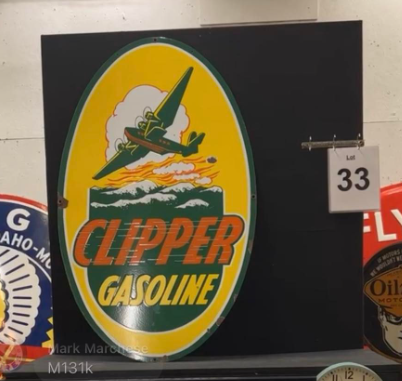When most people think of antique signs, they imagine a rusty relic hanging in a garage or a quirky decoration in a man cave. But for serious collectors, these signs are historical artifacts—and in some cases, six-figure investments. That’s exactly what happened when a Clipper Gasoline sign sold for a staggering $132,000 at auction. So, what makes a piece of vintage advertising command such a premium?
Let’s explore the reasons behind the high value of the Clipper sign and look at other signs that have fetched eye-popping prices.
1. Extreme Rarity
Clipper Gasoline was a regional, short-lived brand, meaning fewer signs were ever produced compared to giants like Texaco or Shell. When production stopped, most signs were either scrapped, damaged, or left to rust away.
Today, only a handful of Clipper signs are known to still exist in good condition—making them incredibly rare. Rarity is the #1 driver in antique sign valuation. If a collector has been chasing a Clipper sign for years and one finally hits the market, the gloves come off.
2. Condition and Originality
The $132,000 Clipper Gas sign was not just rare—it was in near-mint condition. Original gloss, vibrant colors, and no restoration are major factors.
Collectors prize unrestored signs with minimal wear, especially those with porcelain enamel finishes. Any restoration—even minor—can drop the value by 50% or more in high-end circles.
3. Visual Appeal
The Clipper Gas sign features a sleek art-deco style ship logo—bold, colorful, and visually striking. Graphic appeal plays a huge role in price, particularly when the subject evokes Americana or adventure.
Signs that are large, colorful, and have unique graphics (like planes, trains, or ships) consistently outperform plainer designs.
4. Brand Obscurity with Cult Appeal
Unlike Mobil or Gulf, Clipper isn’t a household name—which is exactly why collectors want it. Obscure brands with unique identities develop a cult following.
This dynamic is also seen with brands like:
- Polly Gas – A stunning green parrot logo, signs have sold for $80,000+
- Harley-Davidson Oil – A round double-sided porcelain sign sold for over $95,000
- Musgo Gasoline – One of the most legendary in the hobby, a Musgo sign once sold for $164,700
5. Auction Setting and Collector Competition
High-end signs often hit record prices at specialty auctions like Mecum Auctions, Morphy Auctions, or Petrolicious events, where collectors gather in droves with deep pockets.
When two or more collectors absolutely must have the same piece, prices can skyrocket quickly—sometimes doubling the expected value.
6. Size and Double-Sided Features
Large-format signs (48″ or more in diameter) and double-sided porcelain signs are among the most desirable. The Clipper sign was both.
Size matters in the world of signage. Bigger signs are harder to find in good condition and demand more space to display—adding to their prestige and exclusivity.
7. Documented Provenance
The Clipper Gasoline sign had known provenance, meaning it had a traceable history that helped confirm its authenticity and uniqueness. This matters greatly in a market where fakes and reproductions are a real concern.
Final Thoughts
The $132,000 Clipper sign sale is a perfect storm of rarity, condition, desirability, and collector competition. It shows that the world of antique signage is not just about nostalgia—it’s about investment-grade Americana.
If you’re sitting on a vintage sign—or stumble across one in a barn, attic, or roadside antique store—take a closer look. You might just be looking at a small piece of history worth a small fortune.
Looking to sell your vintage sign?
We offer expert evaluation and fair cash offers. Whether you’re cleaning out an estate or thinning your collection, we make the process easy and transparent.
📩 For Appraisal:
📞 Call us today or hand-deliver your piece for a top-dollar offer text or call us directly at 916-817-9625


